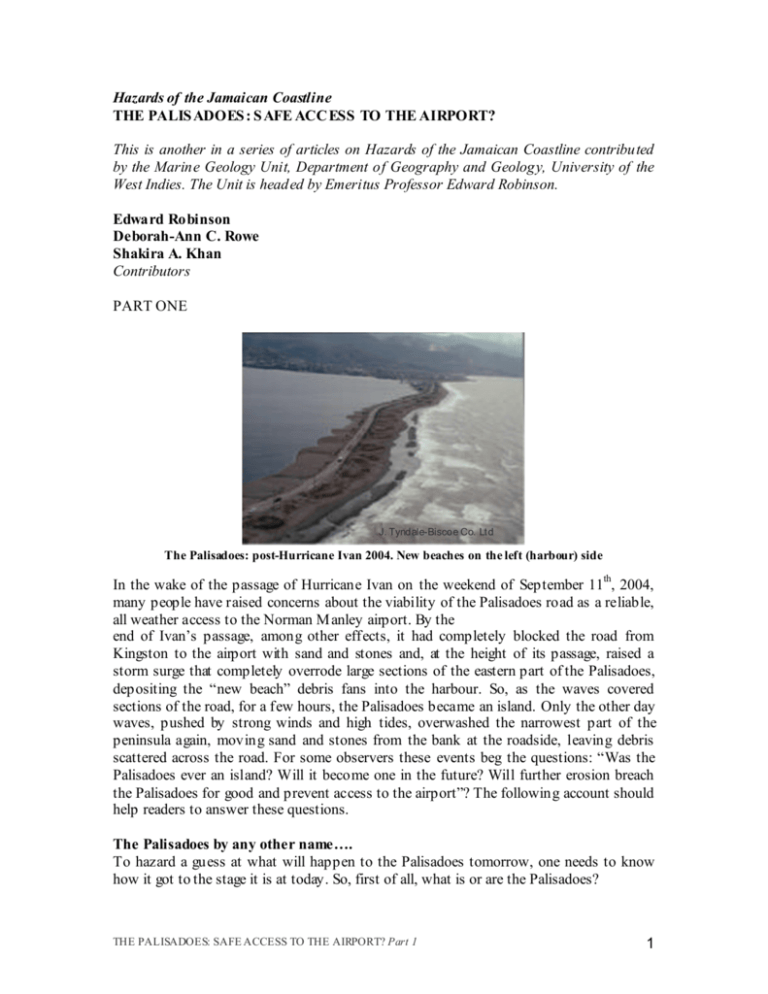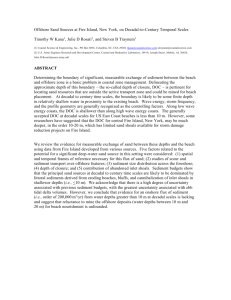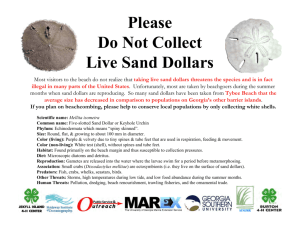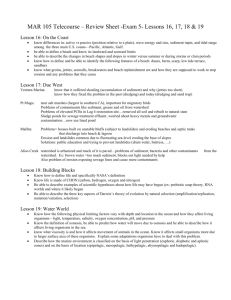A.C. & Khan, S.A. The Palisadoes: safe access to the airport?
advertisement

Hazards of the Jamaican Coastline THE PALIS ADOES : S AFE ACC ESS TO THE AIRPORT? This is another in a series of articles on Hazards of the Jamaican Coastline contributed by the Marine Geology Unit, Department of Geography and Geology, University of the West Indies. The Unit is headed by Emeritus Professor Edward Robinson. Edward Robinson Deborah-Ann C. Rowe Shakira A. Khan Contributors PART ONE J. Tyndale-Biscoe Co. Ltd The Palisadoes: post-Hurricane Ivan 2004. New beaches on the left (harbour) side In the wake of the passage of Hurricane Ivan on the weekend of September 11th, 2004, many people have raised concerns about the viability of the Palisadoes road as a reliable, all weather access to the Norman M anley airport. By the end of Ivan’s passage, among other effects, it had completely blocked the road from Kingston to the airport with sand and stones and, at the height of its passage, raised a storm surge that completely overrode large sections of the eastern part of the Palisadoes, depositing the “new beach” debris fans into the harbour. So, as the waves covered sections of the road, for a few hours, the Palisadoes became an island. Only the other day waves, pushed by strong winds and high tides, overwashed the narrowest part of the peninsula again, moving sand and stones from the bank at the roadside, leaving debris scattered across the road. For some observers these events beg the questions: “Was the Palisadoes ever an island? Will it become one in the future? Will further erosion breach the Palisadoes for good and prevent access to the airport”? The following account should help readers to answer these questions. The Palisadoes by any other name…. To hazard a guess at what will happen to the Palisadoes tomorrow, one needs to know how it got to the stage it is at today. So, first of all, what is or are the Palisadoes? THE PALISADOES: SAFE ACCESS TO THE AIRPORT? Part 1 1 Here we have a strip of land, some 14 km long, that almost completely encloses Kingston Harbour. In the Oxford Dictionary the word PENINSULA is described as “a piece of land almost surrounded by water or projecting far into the sea”, so the Palisadoes may be described as a peninsula. However, the more technically minded persons among us like to define the Palisadoes on the basis of some of its physical properties. Some scientists have called it a SPIT while others have called it a TOM BOLO. A SPIT is defined as a long narrow bit of land made up of beach sediment carried by ocean currents beyond the main shoreline, so that one end of a spit is attached to the shore and the other sticks out into a large body of water. The Palisadoes certainly resembles such a configuration. A TOM BOLO is a bar or spit of sand linking an island to the mainland or to another island, usually forming on the sheltered side of the island. Whether the Palisadoes can be called a tombolo or not depends on whether or not it joins the mainland, at Harbour View, to an island. But which island? The history books tell us that Port Royal was once an island, so that, as Port Royal is now joined to the rest of the Palisadoes, it may also be correct to call the Palisadoes a tombolo. So, we leave it up to you, the reader, to decide on which term you prefer. Semantics aside, in actual fact, the Palisadoes is much more complicated than a simple peninsula, spit, or tombolo would be, for reasons connected with its evolution over the past 5000 years. Natural Processes Maintain the Palisadoes Two major natural processes have come together to build up the Palisadoes. These are the wave action on the coastline and the way fresh sediment is supplied to the coastline. Firstly, ocean waves, breaking on the beaches, are moving the beach and nearshore sand and gavel onto and off the beach every minute of every day. When the weather brings rough waves, the beaches tend to be eroded. In periods of calm weather they tend to build back up. Also, because the dominant waves approach from the southeast, they attack the beaches at an angle. This generates currents near the coastline which move the beach sediment gradually westward along the shore. In this way beach sand that may have been near Harbour View many years ago might now have moved as far as Plumb Point lighthouse and beyond. In time to come it will probably reach Port Royal. THE PALISADOES: SAFE ACCESS TO THE AIRPORT? Part 1 2 Palisadoes groynes: breaking waves and structural mitigation This movement of sediment from east to west does not occur at a steady pace. During stormy periods the energy of large breaking waves is able to move large sized pebbles and boulders, whereas in times of calm seas longshore movement of sand predominates and the whole process of transport along the shore is slower. On stretches such as that fronting the airport, the waves approach the beach and carry sediments in and out at right angles to the shore. Along here too the wind has generated sand dunes that were up to 5 or 6 metres high before Hurricane Ivan. This longshore drift of sediment to the west is a good thing. It is what keeps the Palisadoes in being as a dynamic system. But if this is a continuing process, where do fresh supplies of sediment come from at the Harbour View end? Without new sediment, the Harbour View end of the Palisadoes would gradually be eroded away and eventually disappear. No through road to the airport any more. The necessary sand and gravel is brought to the coast by the rivers to the east of Palisadoes, particularly the Hope River and Cane River, and probably also the Chalky River. As it reaches the coast, some of the river sediment is carried west, by longshore drift, to supply the Palisadoes. In this way an equilibrium between demand and supply is maintained. THE PALISADOES: SAFE ACCESS TO THE AIRPORT? Part 1 3 Palisadoes sediment sources The stability of the Palisadoes, then, depends on the arrival of fresh, river-produced sediment from the east. Any interference in this supply could ultimately jeopardize the integrity of the peninsula and the airport road. Destructive Events These are mainly tropical cyclones, with earthquakes playing a locally important, but infrequent role. There are several good write-ups of the 1692 earthquake, as well as accounts of the subsequent history of Port Royal. Because the rest of the Palisadoes was either a preserve of the military or was more or less uninhabited until the advent of the airport in 1939, much less is known about the effects of destructive events on the peninsula. It is a well-known adage that natural hazards only become hazards when people start living and working in the area. Earth quakes From the point of view of damage to Port Royal and the Palisadoes, the worst earthquake in historical times was that of 1692, which destroyed much of Port Royal, with largely unknown effects on the rest of the peninsula. As most people know, the great earthquake of 1692 caused a landslide into Kingston Harbour that swallowed up a large portion of the old “wickedest city on earth”. The Kingston earthquake of 1907 also resulted in the disappearance of a part of the Port Royal area by slumping into the channel to the harbour, leaving behind upheaved relics such as Giddy House and the Victoria Battery. In 1957 the earthquake that damaged much of M ontego Bay also caused minor slumping of the beach at Port Royal. The main reason why earthquakes always seem to trouble Port Royal is because much of the land there is new land, being created by the same longshore drift of sediment from further east. When the sand reaches Port Royal it has reached the end of the line, and with nowhere else to go, gets deposited to extend the existing beach areas on the south side of Port Royal. The new land thus created is potentially very unstable and earthquake shocks will frequently dislodge it into the ocean. THE PALISADOES: SAFE ACCESS TO THE AIRPORT? Part 1 4 Hurricanes The worst hurricane on record appears to be that of 1722. It lasted 14 hours, raised a fivemetre storm surge in Port Royal, made that town an island again, and created five breaches or channels through the eastern part of the Palisadoes. It is possible to overlay a map made in 1722, right after the storm, on a modern map of Palisadoes. The positions of the five breaches of that map can then be compared with today’s conditions. The positions of the breaches correspond to anomalies in the water depths on the harbour side of the Palisadoes. It is tempting to suggest that these anomalies may represent the remains of washover sand and gravel from the 1722 hurricane, dumped in the harbour, much like the new beaches created by Ivan. The westernmost breach of the five appears to have been the most serious one. It persisted for some time and was reopened as late as 1782. Its site today is at one of the narrowest parts of the Palisadoes, A series of groynes was constructed here in the 1950s, but are now in a very poor state of repair. The washover that occurred on July 7th, 2006 almost exactly marks the spot of that fifth breach. If the 1722 hurricane put 5 metres of water in Port Royal, where wave energies are comparatively low and there is some reef protection, even from the south, it is not surprising that the eastern Palisadoes had holes eroded in it. Beach Rock on the Palisadoes Nevertheless, this same narrow, eastern stretch of the Palisadoes is has proved to be surprisingly resilient to storm damage. Even the oldest maps show it to be the same shape as it is today. Why is this so? Because no investigation by drilling has been done as yet, we have no direct information on what this eastern part is made of. It cannot just be loose sand and gravel, for this would have moved and changed shape over time. One possibility is that the sediments of this stretch have become cemented naturally to form BEACH ROCK, a material that resembles concrete. This would certainly resist erosive processes. M uch of the modern beach contains layers of tough beach rock along the seaward shore of the Palisadoes in this area. Perhaps the most prominent example is the beach rock exposure that has been used as a foundation for the limestone boulders that were placed as a, hopefully, temporary form of protection for the narrow part of the peninsula. We say THE PALISADOES: SAFE ACCESS TO THE AIRPORT? Part 1 5 temporary, because there is ample evidence from other sites we have surveyed along the Jamaican coastline that a storm equal in intensity to Ivan would probably move many of those boulders and put them right in the middle of the roadway. Limestone boulders placed on beach rock (at far left) at the Palisadoes narrow spot We have thus far made note of three times when the Palisadoes became an island. Join us for the next article in the Hazards of the Jamaican Coastline series when we outline how the Palisadoes probably formed from string of cays, and how it might develop in the near future. Website http://www.mona.uwi.edu/geoggeol/M GU/ E-mail mgu@uwimona.edu.jm THE PALISADOES: SAFE ACCESS TO THE AIRPORT? Part 1 6








